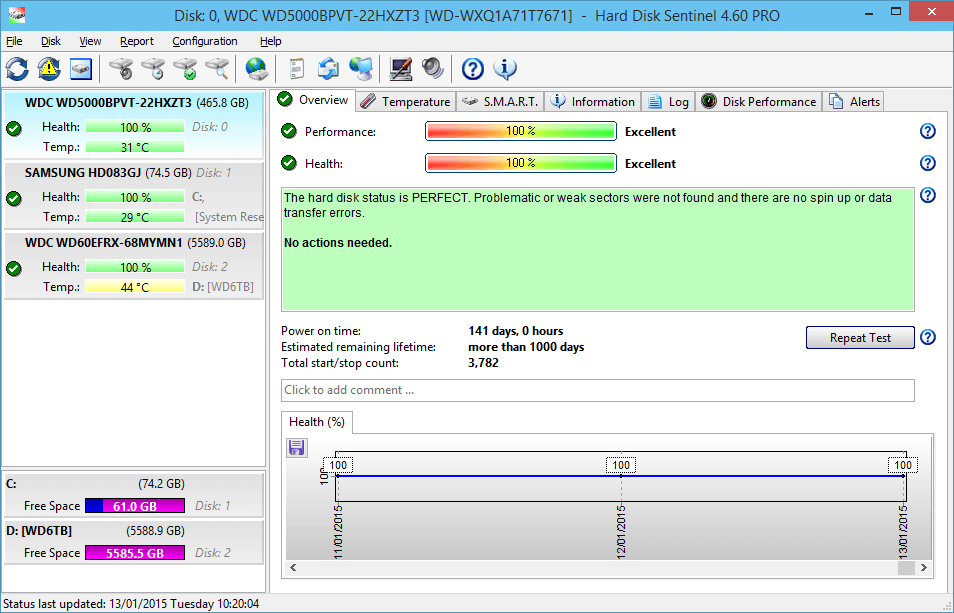

- Test ssd health install#
- Test ssd health drivers#
- Test ssd health update#
- Test ssd health driver#
- Test ssd health manual#
This can be a problem if the PC’s motherboard does not supply enough power to the USB port you are using or if the drive is plugged into a non-powered hub. EHDs that have their own power supplies tend to work more reliably. USB cables can fail after prolonged use, though this is more likely to happen to the Micro USB cables used with mobile phones. External hard drive cables rarely fail unless they get the same sort of abuse. However, if you have two devices that use the same type of cable, you can swap them over to see if that solves the problem.Īlternatively, it could be a software problem.
Test ssd health driver#
#USB CONNECTED SSD HEALTH TEST DRIVER#įor example, it could be the lack of a suitable driver, a corrupted driver or a conflict with another USB device. If you do not have a backup and cannot get the drive to work, it may be worth rolling back to Windows 7 and making a backup before reinstalling Windows 10 – or enlisting the help of a friend who is still running Windows 7. USB flash drives are useful for creating cheap backups. You should never lose data because an external USB hard drive fails. Ideally, you should have at least three copies of your photos stored on different media and at least one should be kept in a different place. Schofield’s Second Law of Computing states that data doesn’t really exist unless you have at least two copies of it.

You can back up your photos to thumb drives, SD cards, optical discs (CD, DVD, Blu-ray), external hard drives, a local network server or an online service. See my recent answer to “ Where’s the cheapest place to store 500GB of data online?” Diagnostic software These include Amazon Photos, Apple’s iCloud, Microsoft OneDrive, Google One and third-party services such as pCloud and Mega.NZ. The major hard drive manufacturers have the most experience in debugging hard drive problems and some have free software to help. The leading examples include WD’s Data Lifeguard Diagnostics and Seagate’s SeaTools for Windows. If not, check your EHD manufacturer’s website for a tool that could find and fix your missing drive. Often, if a device is not recognised by one port, it will work when plugged into a different port or a different PC. If not, the traditional approach – basically, turning your PC off and on again – often works.įirst, unplug the EHD, unplug it from the mains and unplug and straighten the data cable. Second, restart your PC and wait for two minutes (because Windows 10 keeps loading things in the background even after it claims to be ready for use). Third, plug the connecting cable into the EHD, making sure it is firmly seated.
Test ssd health manual#
#USB CONNECTED SSD HEALTH TEST MANUAL#įinally, plug the EHD back into the mains, turn it on (if it has a manual switch) and plug the USB cable back into the PC.
Test ssd health install#
With luck, either the PC will recognise the external drive or discover it as a new device and install it with a suitable driver. Turning a PC off and on does not work as well as it used to because of Windows 10’s Fast Startup system. Ideally, we want the PC to forget everything and make a fresh start. With Fast Startup, Windows 10 stores core parts of memory, including the drivers, in a hidden file called hiberfil.sys and just reloads this file when you turn it back on. #USB CONNECTED SSD HEALTH TEST WINDOWS 10# You could temporarily disable Fast Startup but I’d just move on to the next step.
Test ssd health drivers#
Uninstall, reconnectĭevice Manager is the program you need to manage drivers and see whether there’s a problem. If a reboot doesn’t make Windows renew its USB drivers, you can do it manually. With the EHD plugged in, go to the Start menu and type or paste the words “Device Manager” into the search box, then run the app that comes up. Next, click the arrow (>) next to “Disk drives” in the Device Manager program to see a list of the drives that your PC knows about. Look for the drive that is not being recognised. It should be obvious from its name, which might be something like “WD Ext HDD 1021 USB Device” or “WD MyBook” or “Seagate Expansion Desk”, or whatever. Right-click on your EHD and select “Uninstall device” from the pop-up menu. When that has finished, unplug the USB cable. Wait a minute, then plug the USB cable back in. Windows should see the drive and install a driver.

Your EHD should then appear in the “This PC” section of Windows 10’s File Explorer. If this doesn’t work, use the Settings app to run Windows Update, restart your PC and try again.
Test ssd health update#
Windows Update delivers new drivers and software patches when they become available. #USB CONNECTED SSD HEALTH TEST WINDOWS 10#.#USB CONNECTED SSD HEALTH TEST DRIVERS#.#USB CONNECTED SSD HEALTH TEST INSTALL#.


 0 kommentar(er)
0 kommentar(er)
